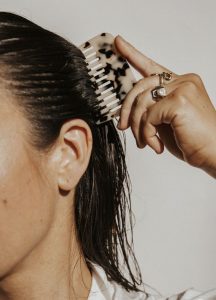
So what do we know? Deficiencies of riboflavin, biotin, zinc, iron, or iodine; iron overload, selenium toxicity, and vitamin A toxicity can all cause hair loss, or in medical jargon, alopecia, but none of these has as much evidence for being a very common cause of hair loss as iron deficiency. Yes, know your iron status please.
As reviewed here:
Convincing hey. Thus, if you know you qualify as deficient it’s a much surer bet that fixing the deficiency will get rid of the hair loss. So be proactive please. What’s a healthy ferritin above 50 for sure, but remember we look at all the iron panel as some of us have a fatty liver that gives us a false high. So you need all markers in a healthy range.
How Does Iron Help Hair Loss?
Some potential mechanisms mentioned in human studies include these:
One study found that in human keritinocytes, iron deficiency impaired keratin expression while cysteine abolished this effect. Keratin is an important component of hair. It appears that cysteine upregulated ferritin, which helped retain iron in the cell that would have otherwise been depleted by the chelator they were using to induce iron deficiency. However, as I covered in Understanding Iron, hydrogen sulfide releases iron from ferritin. Cysteine is the main source of hydrogen sulfide. So it is also possible cysteine would support the dynamic release of iron from ferritin, making it available for use in iron-dependent enzymes.
This study found that topical application of 5-aminolevulinic acid (5-ALA, a precursor to heme, which contains iron), was slightly better at stimulating hair growth in mice than iron alone, but that topical application of both together was much better and was as effective as minoxidil, which is used for androgenic alopecia.
Even Minoxidil a gold standard is thought to work by increasing blood supply to the follicle. This mouse study suggests the effect of iron is mediated by heme synthesis. So Correct iron imbalance first.
Further, the systemic delivery of oxygen would be improved by increased heme synthesis in red blood cell precursors of the bone marrow, so topical application is probably increasing heme synthesis in the follicle itself, and that is probably working through improved mitochondrial energy metabolism.
After all, if delivering oxygen to the hair follicle works, then you can bet the farm that improving energy metabolism in the hair follicle by any other means will work, because the whole point of delivering oxygen to the hair follicle is to use in in the mitochondrial respiratory chain to make ATP.
Iron is also a cofactor for thyroid peroxidase, and is every single bit as essential to thyroid hormone production as iodine is. Hypothyroidism is famous for causing hair loss.
The Bottom Line for a Beautiful Head of hair …

